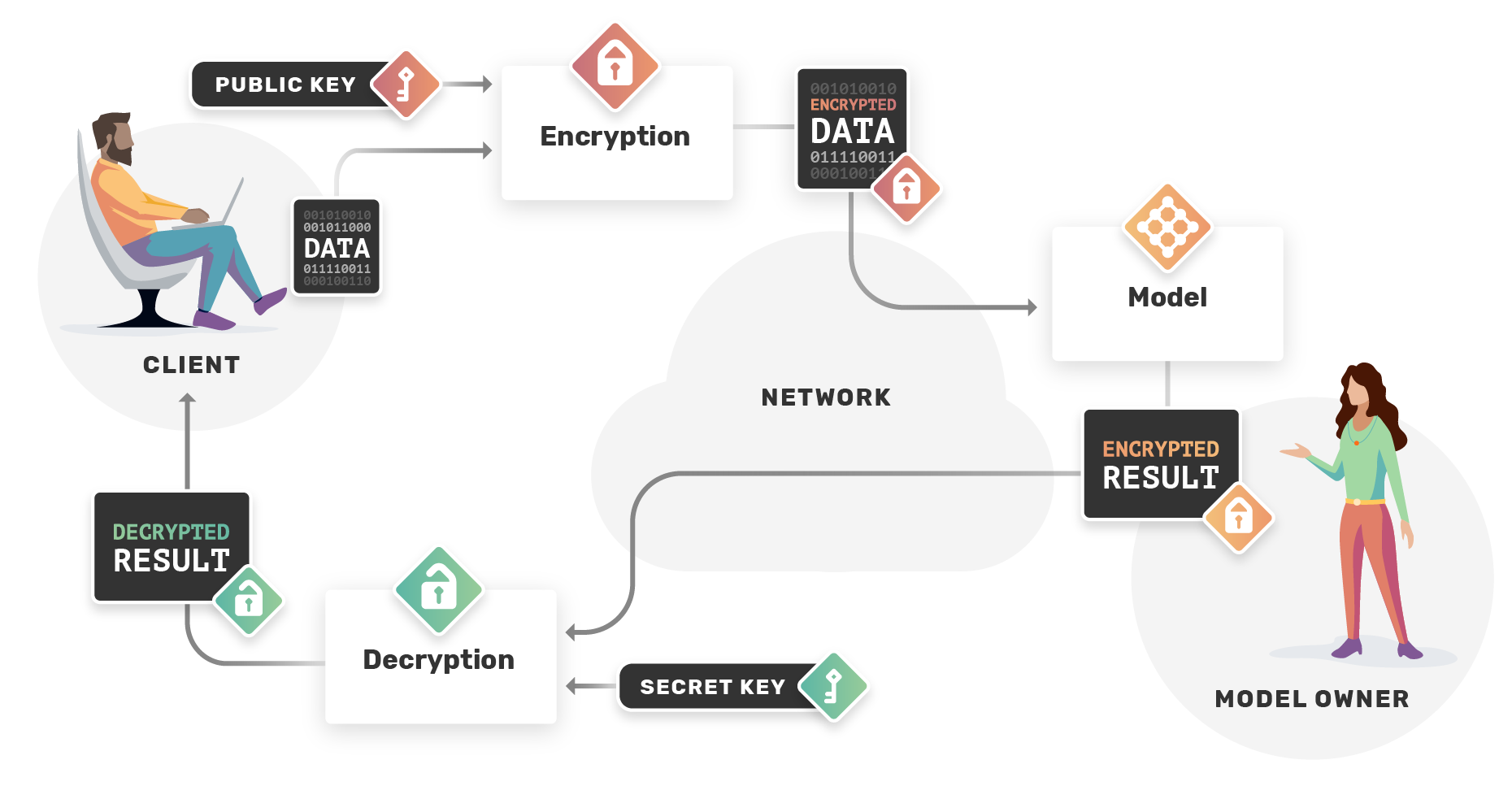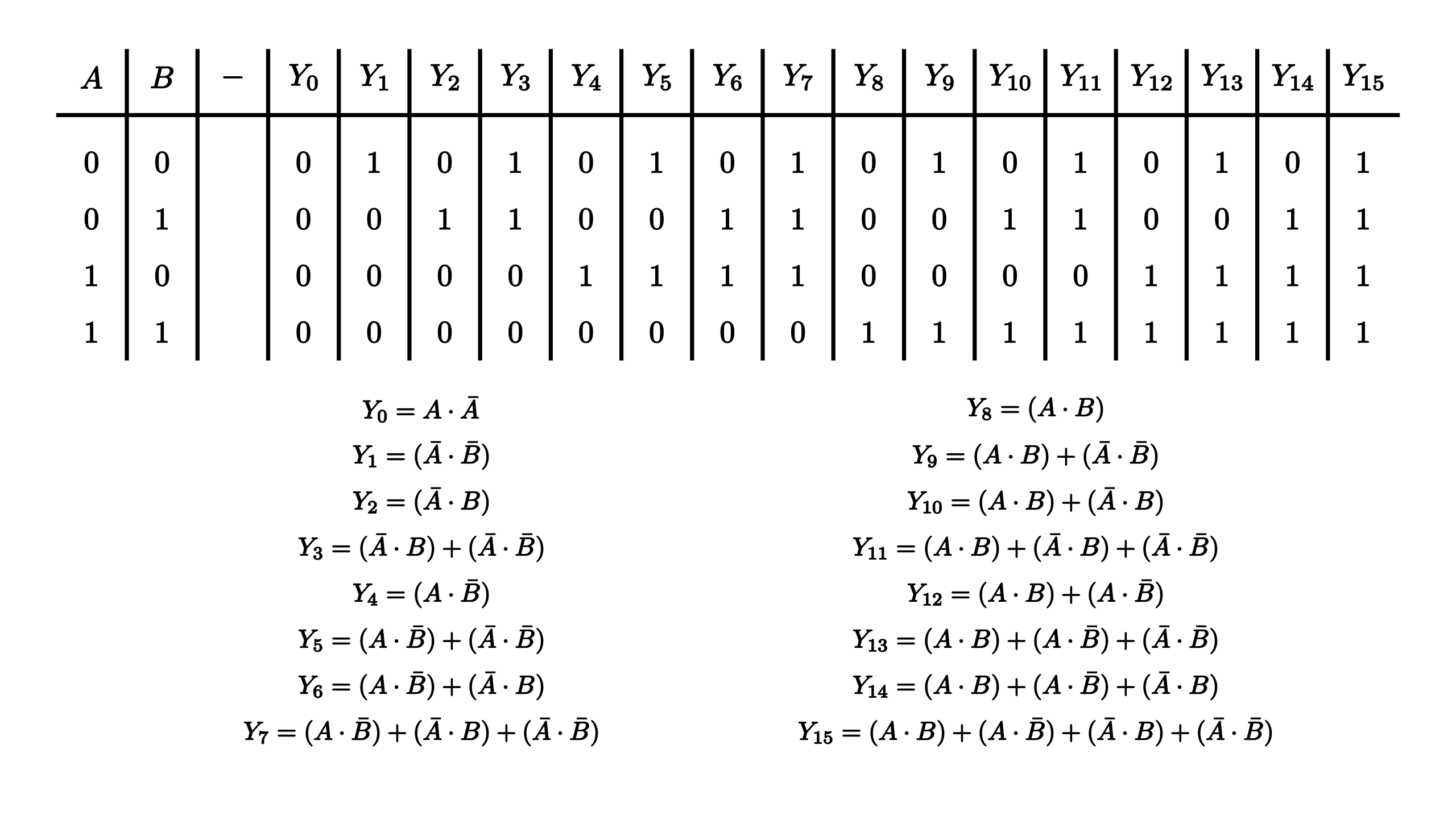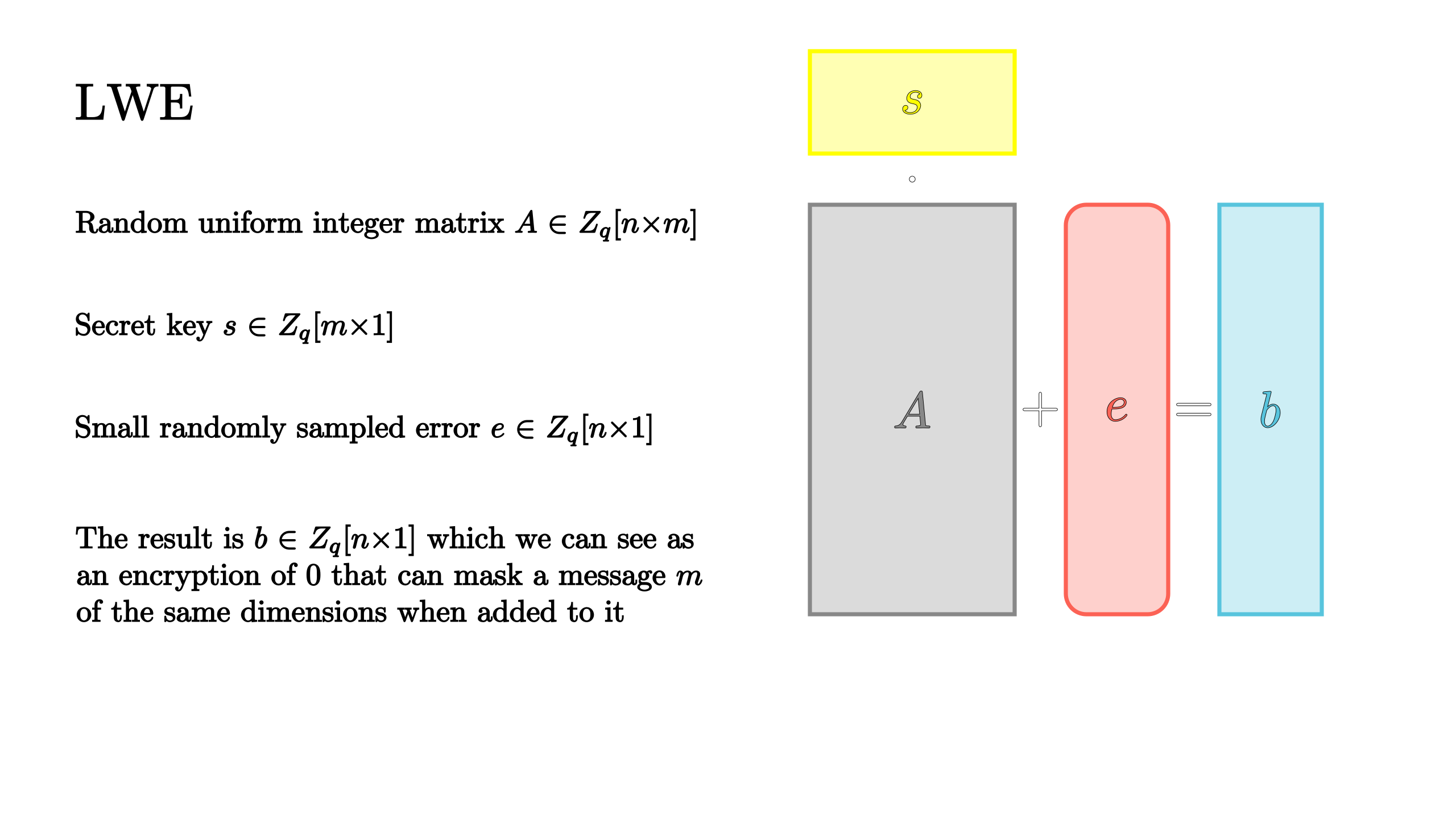This post is part of our Privacy-Preserving Data Science, Explained series.
Check out the companion video to this article on youtube.
Introduction
Input privacy is one of the most relevant issues in private ML. We explored one solution to this problem in Secure Multi-Party Computation. However, if secret sharing was not an option due to the limited number of participants, what's the alternative? Homomorphic encryption(HE) is a kind of encryption that allows computation on encrypted data. In short, HE ensures that performing operations on encrypted data and decrypting the result is equivalent to performing analogous operations without any encryption. So like SMPC, we can use HE to achieve input privacy but with only one party needed to encrypt and decrypt the data.
HE is not only used to protect data owners; model owners have some of the same privacy concerns around their valuable intellectual property (IP) as clients do around their data. Therefore it is crucial when using a model in an untrustworthy environment, to keep its parameters encrypted.
Use cases
Homomorphic encryption has numerous applications that range from healthcare to smart electric grids; from education to machine learning as a service (MLaaS). All sectors where input privacy is paramount and making use of the data is usually already complex due to: regulations, the significance of the data, and security concerns. Other notable uses of the technology involve non-intrusive, privacy-preserving security, i.e., systems capable of detecting nefarious activity from an encrypted and private data source. A useful metaphor for these systems is to think of them as the sniffer dogs of digital data sources. They don't infringe upon anyone's privacy thanks to the encryption, their accuracy can be empirically verified, and since their parameters are kept private, they are not easily reverse engineered. Here's a link to Andrew Trask's article on privacy-preserving security if you want to dive deeper.

Advantages:
- Can perform inference on encrypted data, so the model owner never sees the client's private data and therefore cannot leak it or misuse it.
- Doesn't require interactivity between the data and model owners to perform the computation.
Disadvantages:
- Computationally expensive.
- Restricted to certain kinds of calculations.
Implementation
PySyft supports the CKKS leveled homomorphic encryption scheme and the Paillier partially homomorphic encryption scheme which is limited to addition but is much faster.
More details on CKKS and Paillier are available below in the "theory behind the implementation" section. Here we'll focus on how to use HE in PySyft.
Paillier
After importing and hooking torch with syft's additional functionalities we generate the private and public keys. Using the public key we can encrypt syft tensors and with the + operator we can homomorphically sum them. Intuitively, the private key allows us to decrypt the result of our operations which we can easily print.
import syft as sy
import torch as th
hook = sy.TorchHook(th)
#public and private key generation
pub, pri = sy.keygen()
#encrypting with Paillier
x = th.tensor([1, 2, 3]).encrypt(protocol="paillier", public_key=pub)
y = th.tensor([2, 2, 2]).encrypt(protocol="paillier", public_key=pub)
#encrypted sum
sum = x + y
#decryption with private key
print(sum.decrypt(protocol="paillier", private_key=pri))
#tensor([3, 4, 5])CKKS
To use the more complex and powerful CKKS scheme we can follow similar steps. Besides importing syft and torch for CKKS we also use functions from syft.frameworks.tenseal which integrates the TenSEAL package for performing HE operations on tensors.
import syft as sy
import torch as th
import syft.frameworks.tenseal as ts
hook = sy.TorchHook(th)
#Public and private key generation
pub, pri = ts.generate_ckks_keys()
#Encrypting with CKKS
x = th.tensor([1.2, 2.2, 3.2]).encrypt(protocol="ckks", public_key=pub)
y = th.tensor([2.0, 2.0, 2.0]).encrypt(protocol="ckks", public_key=pub)
#encrypted addition, substraction and multiplication
encrypted_add = x + y
encrypted_sub = x - y
encrypted_mul = x * y
#decryption with private key
print(encrypted_add.decrypt(protocol="ckks", private_key=pri))
print(encrypted_sub.decrypt(protocol="ckks", private_key=pri))
print(encrypted_mul.decrypt(protocol="ckks", private_key=pri))
#tensor([3.2, 4.2, 5.2])
#tensor([-0.8, 0.2, 1.2])
#tensor([2.4, 4.4, 6.4])Theory behind the implementation
Since 1978, when the idea of Fully Homomorphic Encryption (FHE) was first formalized, several cryptosystems have been invented to get closer to computing arbitrary functions on ciphertext. However, until Craig Gentry introduced the crucial technique of bootstrapping in '09, they were all partially or somewhat homomorphic encryption schemes. To understand why that is the case, it's important to define more precisely what "computing arbitrary functions" means.
At the level of bits and logic gates, successive combinations of AND and XOR can express any boolean function. Since these two gates behave respectively as operations of binary multiplication and addition we can conclude that a scheme under which we can perform homomorphic addition and multiplication on ciphertext should be capable of achieving FHE, with some caveats.

The operations of addition and multiplication suggest the use of a ring as the underlying algebraic structure. A set of objects, like integers, is considered a ring if we can perform on it an "addition-like" and a "multiplication-like" operation and if it admits neutral elements for both operations, respectively 0 and 1. Examples of rings are, as we have said, the set of all integers but also the set of all possible remainders of an integer division by a specific n, known as "all integers modulo n". For instance the set of integers modulo 5 Z_5 = {0, 1, 2, 3, 4}, is a ring because we have both 0 and 1 and the addition-like operation that after summing two numbers takes as its result the remainder of the integer division by 5 of that sum. So 3+4 = 7 -> 7%5 = 2. Multiplication works in the same way. 4*4 = 16 -> 16%5 = 1. As we'll detail later we can also build rings with polynomials.
Besides homomorphic addition and multiplication what are the other characteristics common to most FHE schemes?
Somewhat homomorphic encryption (SWHE)
They tend to be based on schemes that are capable of "somewhat" homomorphic encryption. These schemes can only perform a limited number of successive multiplication and addition operations on ciphertext before the results become unreliable and impossible to decrypt. This limitation arises directly from the way these systems guarantee security by relying on noise or error to make relatively simple problems computationally intractable.
Building a FHE scheme
To better understand why error plays such an important role we'll build a simple SWHE scheme and explain how to use it as the basis for FHE.
According to Craig Gentry, as he explains in this series of talks, one of the simplest ways to approach building this kind of scheme is to follow the Polly Cracker framework. The basic idea behind the framework consists in using encryptions of 0 to disguise encryptions of any other message.
In practice we can use this idea to build a simple scheme that encrypts a 1 bit message m={0,1} and that operates in the Z_p ring of integers modulo a large prime p that should remain hidden, it is in fact the secret key.
Let's start with the encryption procedure, if we want to encrypt m we first choose a random but small noise term r << p and also a large q. The encryption of m will be C(m) = m + 2r + qp.
Decryption is as easy as taking the mod p of the ciphertext and then the mod 2 of the result D(C(m)) = ((m +2r +qp) % p) % 2) = (m +2r) % 2 = m.
Addition works intuitively. If we receive two encrypted messages C(m1) , C(m2) without knowing the secret key p, we can still send back C(m1) + C(m2) = m1+m2 + 2(r1+r2) + p(q1+q2) which is a valid encryption of m1 + m2 with more noise.
Using multiplication we can operate in a similar way because C(m1)*C(m2) = m1m2 + 2(r2m1+r1m2+r1r2) + p(m1q2+2r1q2+q1m2+2q1r2+q1q2)is a valid encryption of m1*m2. Here the noise grows much faster than in addition.
Before talking about why a growing noise term is such a crucial issue let's focus on why we need it in the first place. If we were to remove the noise from our scheme it would still be capable of performing homomorphic addition and multiplication. However, to break the noise-less scheme an attacker would just need to get a hold of two encrypted messages and proceed by simply calculating the greatest common divisor for which there is the Euclidean algorithm that runs linearly with the number of digits in the smallest input.
If we add noise, the problem becomes much more difficult. In the literature it is known as the Approximate Greatest Common Divisor (GCD) or Approximate Common Divisor (ACD) problem and with reasonable parameters it is considered hard to solve.
Learning with Errors
Approximate GCD is not the only problem used to secure FHE, in fact numerous recent schemes employ the Learning With Errors problem which is also conjectured to be hard to solve.

In its most basic formulation the problem states that, given a random uniform integer matrix A and a very small integer vector error e, if we multiply A by a secret vector s and then sum e, recovering s from the resulting vector b without e is computationally intractable even if knowing the matrix A. Similarly to the scheme we explained before, As + e can be thought of as an encryption of 0 and, from that starting point, a different scheme can be developed as presented by prof. Daniele Micciancio in this talk with intuitive addition and multiplication.
Dealing with Error/Noise
Even schemes that rely on LWE however, we see the noise rise as successive additions are performed and even more so with multiplications. To understand why that is a problem we'll go back to our first scheme with an example.
Let's say, to keep things simple, that we would like to add to itself a number three times Cp(0) = 0 + 2 * 5 + 68 * 29 = 1982 the number is m=0 encrypted with secret key p=29.
Cp(0)+Cp(0)+Cp(0) = 5946 = 0 + 2*(15) + (204)*29 as always 5946 doesn't tell us much about the result of our calculation but with p we can decrypt it as we detailed above. We start with 5946%29 = 1 and then we check whether the result is even or odd, 1 is odd so we conclude 3m=1 but of course we know that is not the case so what went wrong?
The error term has gotten too big and instead of being even it's now odd. Since 30 is bigger than p=29 the modulo p operation that usually doesn't effect the error because it's too small has now changed it, corrupting the encryption. This example is specific to our scheme and the noise was a little too high to begin with. The behavior of all SWHE schemes become unpredictable as the error grows larger.
Bootstrapping
So is there a way to decrease the error? Yes, bootstrapping is a technique that involves running the decryption procedure homomorphically without revealing the message and using the encrypted secret key.
To give a sense of how this is possible we should keep in mind that we can produce a series of XOR and AND gates or additions and multiplications that perform the decryption operation. In our scheme, the modulo p followed by modulo 2. Furthermore, the scheme we presented here encrypts binary messages. To get an encryption of the secret key we simply need to have an ordered set of encryptions of its bits.
With these two ingredients we can perform homomorphic decryption and eliminate the noise produced by previous operations. Homomorphic decryption however injects some noise of its own, like any other function. As long as we can still perform reliably one operation of addition or of multiplication before needing bootstrapping again we have reached FHE.
This is the recipe for most proposed FHE schemes, an underlying SWHE scheme that supports addition and multiplication, usually secured by adding noise, and a way to reduce the noise when it grows too large, usually by bootstrapping.
Some notable HE schemes and where to learn more about them
The following are some examples of HE schemes: some partial, others fully homomorphic. I have provided short descriptions and links to resources to understand them better.
Paillier
In 1999 Pascal Paillier invented a partially homomorphic, asymmetric cryptosystem now bearing his last name. Paillier's scheme is homomorphic with respect to addition. For more details on the actual algorithm take a look at the article dedicated to it on our blog.
In short, it achieves HE with respect to addition by encrypting the message as an exponent of the public key. This way when multiplying two ciphertexts encrypted with the same key the result is a valid encryption of the sum.
Original paper: Public-Key Cryptosystems Based on Composite Degree Residuosity Classes
Video resource: Implementation of Homomorphic Encryption: Paillier
CKKS
CKKS has been developed by researchers at Seoul National University and UC San Diego and it is characterized by using the approximate nature of floating-point arithmetic as part of the LHE scheme.
OpenMined uses CKKS as the primary way to encrypt tensors on which we want to perform both addition and multiplication.
OpenMined demo on CKKS: Homomorphic Encryption in PySyft with SEAL and PyTorch
Original paper: Homomorphic Encryption for Arithmetic of Approximate Numbers
Video resource: Introduction to CKKS (Approximate Homomorphic Encryption)
BFV
It uses rings over polynomials and has an approachable construction similar to the scheme we described in this post but using LWE. It was developed by Brakerski,Fan and Vercauteren. We have a beginner friendly post on how to implement it in Python.
OM Implementation: Build an Homomorphic Encryption Scheme from Scratch with Python
Great Blogpost: A Homomorphic Encryption Illustrated Primer
Original Paper: Somewhat Practical Fully Homomorphic Encryption
GSW
GSW uses LWE applied to linear algebra where the messages are encrypted as eigenvalues of matrices which have a common eigenvector. GSW was developed by Craig Gentry, Amit Sahai, and Brent Waters.
Original Paper: Homomorphic Encryption from Learning with Errors:Conceptually-Simpler, Asymptotically-Faster, Attribute-Based
Video resource: Fully Homomorphic Encryption
BGV
BGV can use modulus switching, an alternative technique for noise management. BGV was developed by Zvika Brakerski,Craig Gentry and Vinod Vaikunathan.
Original paper: Fully Homomorphic Encryption without Bootstrapping
Libraries for HE
SEAL is an open-source library developed by Microsoft that implements the BFV and CKKS schemes in both their symmetric and asymmetric versions. The library is written in C++ but has many wrappers for Python and JavaScript.
HElib supports BGV and CKKS with a focus on ciphertext "packing" techniques that increase the efficiency of the base schemes. To describe the library approach to HE the developers have written that in HElib "The underlying cryptosystem serves as the equivalent of a "hardware platform", in that it defines a set of operations that can be applied homomorphically, and specifies their cost." HElib has been developed in C++ by researchers at IBM and it is open-source.
Python-paillier open-source implementation in python of the Paillier scheme.
TFHE implements HE at the binary gate level with a ring-variant of the GSW scheme and applies gate-by-gate bootstrapping. cuFHE is the cuda enabled version of TFHE. The library is open-source and written in C.
Palisade is an open-source library supported by DARPA that implements the BFV, BGV, CKKS, TFHE, FHEW schemes and provides other useful features to support lattice-based cryptography.
You might also be interested in: Homomorphic Encryption in PySyft with SEAL and PyTorch, Build an Homomorphic Encryption Scheme from Scratch with Python, What is the Paillier Cryptosystem?





